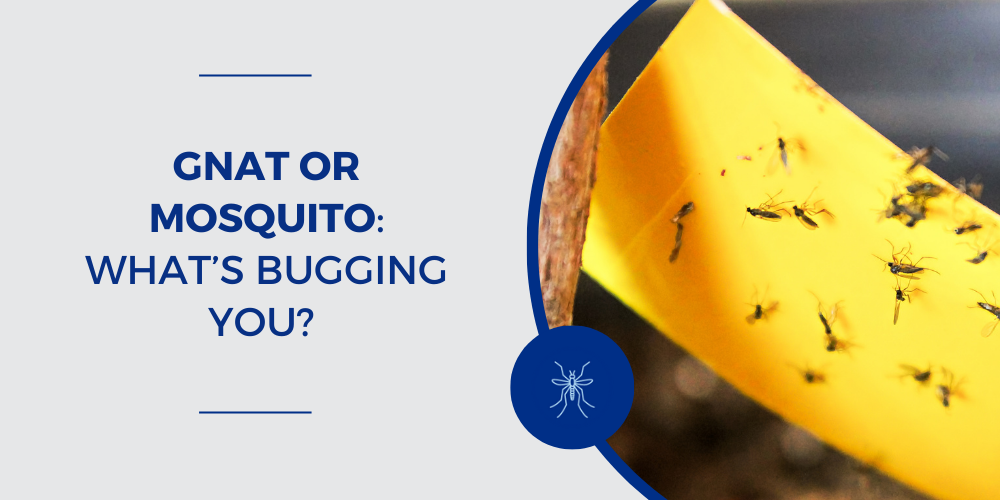The appearance of small, itchy bumps on your skin can be the first sign of a pest problem. While there are a variety of insects that “feed” on humans, you may be surprised to learn that gnats might be the culprit. They are tiny flying insects with slim, dark-brown bodies and some gnat species will bite. Their petite size often causes confusion, commonly leading them to be misidentified as mosquitos or other pests.
Typically, the small flies found buzzing around your kitchen are gnats, but they can often be mistaken for mosquitos. Gnats and mosquitos are both part of the Diptera fly family and they share noticeable similarities. Their common traits also give gnats the same negative reputation associated with mosquitos. Learning to identify the similarities and differences between these two pests is helpful in understanding the best way to avoid them.
How Gnats and Mosquitos Similar
Often mistaken for one another, let’s first look at the many notable similarities between gnats and mosquitos to help tell these two insects apart. A few ways they are similar include:
Attraction to Moisture
Both pests are attracted to moisture. When you see a swarm of insects flying around, you will frequently find stagnant bodies of water nearby. Freshly watered grass and damp soil areas also provide ideal breeding grounds. Wet conditions are perfect for laying eggs and offer gnats and mosquitos access to food and shelter essential for growth.
Food of Choice
Male gnats and mosquitos both consume decaying organic plant matter and sugar. They seek sources like fruit plants, roots, stems, and nectar. Female mosquitos require a protein in the blood called serum albumin to produce eggs. Although female gnats do not typically consume blood, the exception is biting gnats. Female biting gnats, like mosquitos, require blood for reproduction.
Period of Activity
The summer months between March and October are when gnats and mosquitos are most often found. Their activity peaks significantly in summers following winters with heavy rainfall and humidity.
How Gnats and Mosquitos Differ
At this point, we can see these pests have strong similarities, but there are some differences that can be used to help tell them apart. Some ways that can distinguish the gnats from mosquitos include:
Features
While it may be tough to see, a notable difference between the appearance of the two pests is a mosquito's distinct stripes. Most mosquitos have stripes on their abdomen, legs or wings, which gnats lack.
Size And Shape
Size is the most recognizable difference. Mosquitos can grow up to 3 times as big as gnats with long, outstretched wings. Gnats are much smaller, ranging from 1/16 to ⅛ of an inch long. Gnats have circular abdomens and round heads, while a mosquito’s body is longer and its head is more spherical.
Sounds
Mosquitos make a buzzing sound that is triggered by the flapping of their wings. The buzz can vary depending on the species of the mosquito and the speed of its wing movement. Gnats are virtually silent, making little to no noise.
If you determine the swarm of bugs flying around your home are gnats, the next step is determining what kind of gnat you are dealing with.
Three Gnats Are Most Commonly Found Indoors:
Fungus Gnats
Fungus gnats are known for killing houseplants. They feed on the nutrients in the damp soil before the plant can.
Fruit Gnats
Fruit gnats, as the name suggests, are attracted to over ripened fruits. Keep kitchen surfaces clean and remove bowls of fruit left on the counter for too long.
Drain Gnats
Drain gnats feast on matter found near pipes around the kitchen and bathrooms.
Are Gnats Harmful?
Imagine a gnat flying around your face while you sit in front of the computer working. Although it may harmless you, it is certainly a nuisance. Gnats tend to fly around your face, as the moisture from the mouth and nose attracts and draws them in. Again, definitely annoying but it’s not dangerous. The gnats you need to beware of are female biting gnats, which can be tough to identify. A gnat bite will cause a small bump on the skin that can become red and itchy. Only in rare cases a gnat bit can carry disease. Mosquitos are more of a threat when it comes to bites and disease.
Overall, gnats are not dangerous to humans, but they can cause damage to plants. Gnat larvae will feed on plant roots and absorb essential nutrients in the soil. Keeping your house and garden plants safe from gnats is easy to combat with the right pest solutions.
Getting Rid Of Gnats
To keep your home and garden gnat-free hear are prevention measures you can implement:
Regularly Clean Drains
Use bleach to clean drains in the kitchen, bathrooms and other sinks in and around your home. Remember, drain flies or gnats feed on residue found in drains. Bleach is one of the best treatments for getting rid of the residue in sinks and drains, which cuts off the gnats food source.
Dispose of Overripe Fruit
Fruit and vegetables that are past their expiration date omit a sweet smell that attracts fruit flies. We recommend storing produce items in the refrigerator rather than in a bowl on the kitchen counter. Storing fruit in the refrigerator also allows it to last longer. If produce is left out too long, it’s best to dispose of as soon as possible in a sealed garbage bag to keep gnats away.
Remove Trash
Garbage attracts just about every pest from rodents to gnats. Keeping trash properly sealed and taking it out often will eliminate the food source that invites pests into your home.
Avoid Over Watering
Watering your house and garden plants is necessary, but don’t let the Arizona summer heat entice you to water plants more than needed. Moisture and pooled water invites unwanted pests. The best practice is to set a watering schedule based on the type of plants you have and their location. Then, keep watch to make sure you are not giving plants more water than they need.
Use Fly Traps
Fly traps are easy to use and can be used strategically on a patio or in a home. Glue pads can be placed in and around plants. When a gnat comes near the plant it can be caught in a sticky pad and become trapped. There are a also fly trap lights that can be plugged into an outlet or battery-operated lights that also work well. The light attracts the gnats and other insects and then traps the insects in sticky paper.
We all agree that gnats are not the worst pests to have around the home, but that is not a reason to allow them in. If you have questions about how to get rid of any pest, visit one of our Bug & Weed Mart locations or call to speak with our DIY pest control experts.

